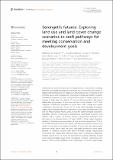| dc.description.abstract | Rapid land use transformations and increased climatic uncertainties challenge potential sustainable development pathways for communities and wildlife in regions with strong economic reliance on natural resources. In response to the complex causes and consequences of land use change, participatory scenario development approaches have emerged as key tools for analyzing drivers of change to help chart the future of socio-ecological systems. We assess stakeholder perspectives of land use and land cover change (LULCC) and integrate co-produced scenarios of future land cover change with spatial modeling to evaluate how future LULCC in the wider Serengeti ecosystem might align or diverge with the United Nations’ Sustainable Development Goals and the African Union’s Agenda 2063. Across the wider Serengeti ecosystem, population growth, infrastructural development, agricultural economy, and political will in support of climate change management strategies were perceived to be the key drivers of future LULCC. Under eight scenarios, declines in forest area as a proportion of total land area ranged from 0.1% to 4% in 2030 and from 0.1% to 6% in 2063, with the preservation of forest cover linked to the level of protection provided. Futures with well-demarcated protected areas, sound land use plans, and stable governance were highly desired. In contrast, futures with severe climate change impacts and encroached and degazetted protected areas were considered undesirable. Insights gained from our study are important for guiding pathways toward achieving sustainability goals while recognizing societies’ relationship with nature. The results highlight the usefulness of multi-stakeholder engagement, perspective sharing, and consensus building toward shared socio-ecological goals. | en_US |

